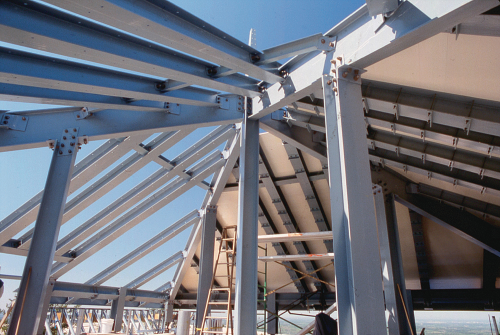
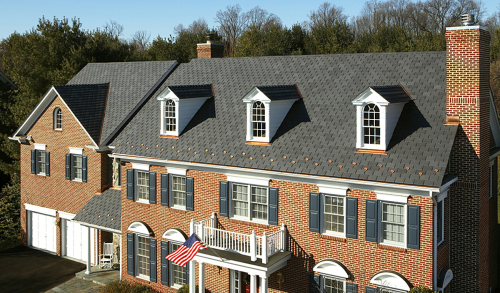
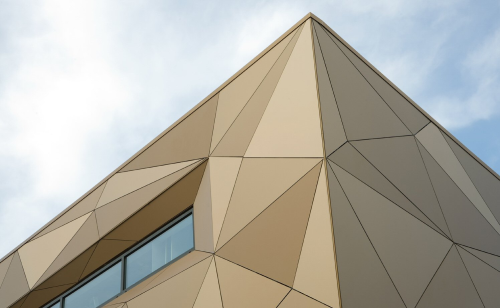

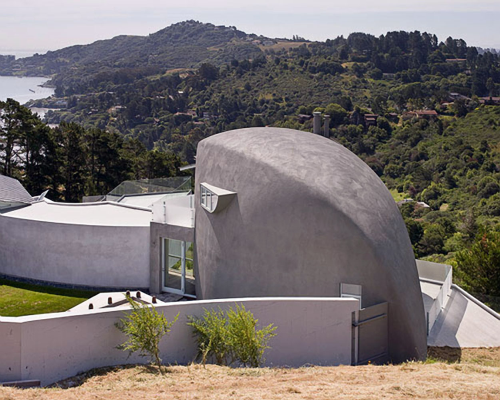
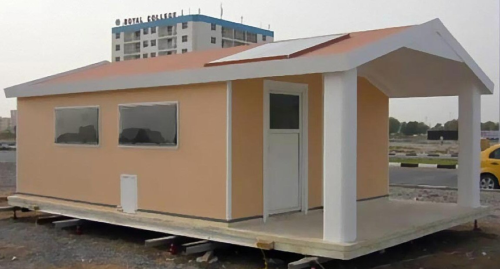
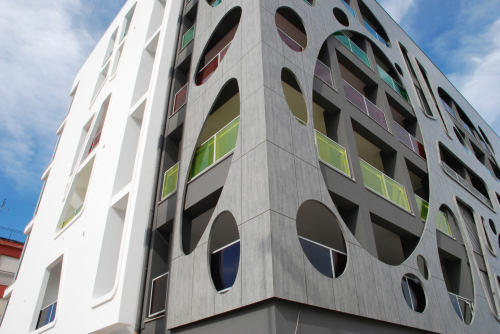
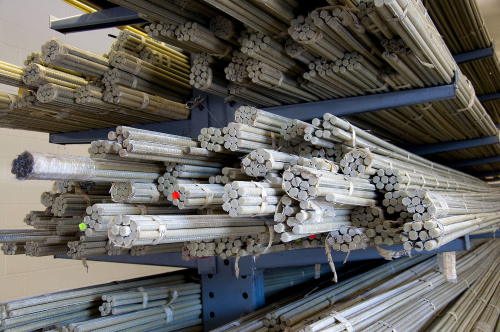
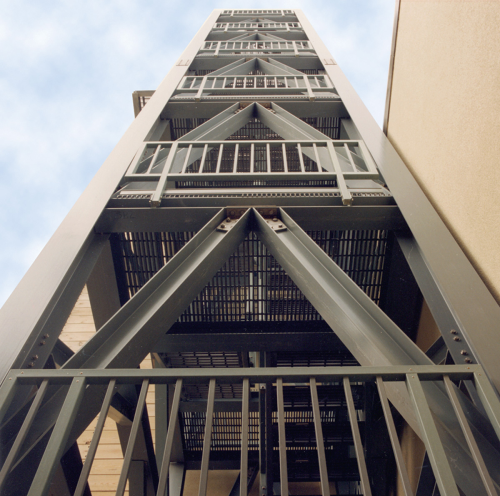
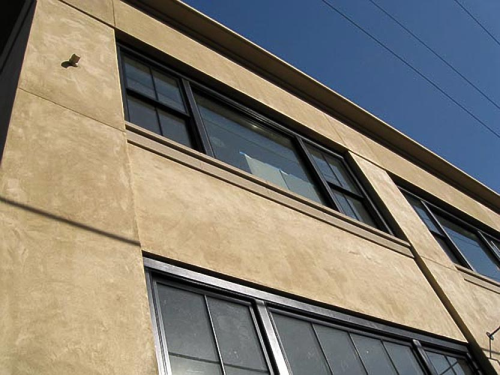
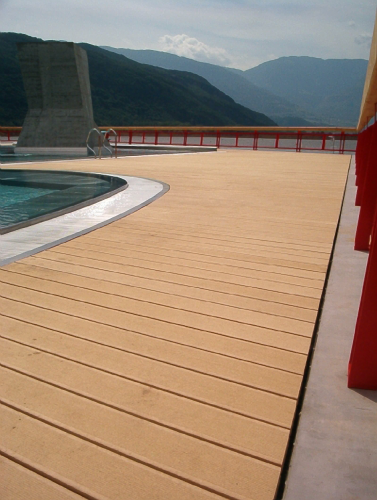
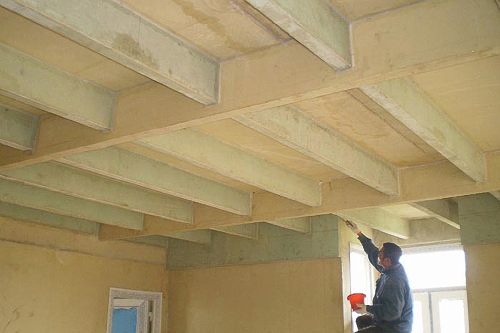
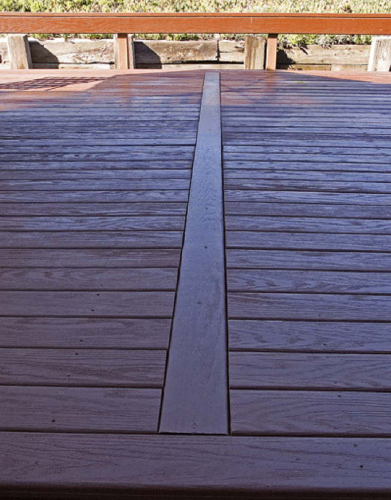
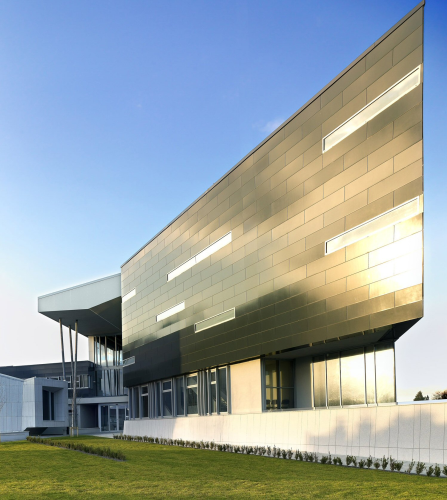
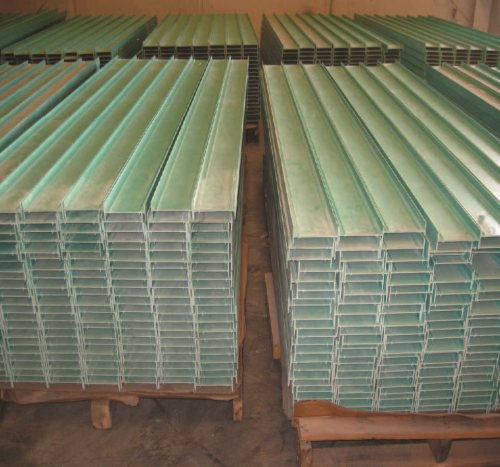
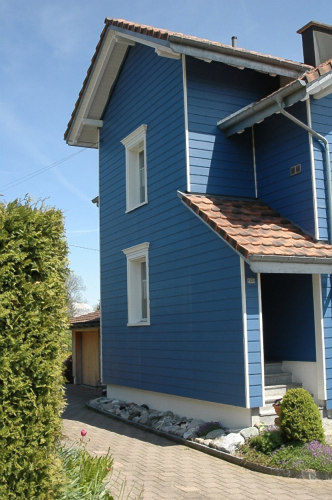
Market researchers at Lucintel report that pent-up demand for composites in construction applications in China is producing double-digit growth there, while in North America, construction applications are expected to expand at a rate of about 5% a year through 2013. In Europe, growth will average over 6% in the same period. Commercial and industrial construction applications are keeping the overall demand for composites from slumping in Europe and the USA, relates Lucintel.
Fibre reinforced plastic (FRP) composites are used in a wide range of applications in construction because of the benefits they provide over traditional building materials. Primary benefits include reduced weight, requiring less supporting structure, and excellent resistance to corrosion and rot, which can significantly reduce the durability of structures built with wood and steel.
Less maintenance and repairs mean reduced life cycle costs. Lighter materials also facilitate handling during assembly, reducing installation costs as well as transportation costs. Composites also offer greater design freedom, enabling the creation of complex shapes.
Early in design stage
Involving the composites engineer early in the design stage of a project is important, observes David Kendall, Managing Director of Optima Projects Ltd, a UK-based consultancy specialising in advanced engineering design, analysis and FRP materials. His firm is currently working on a major construction project in the Mideast, where they’ve handled the composites engineering from the start.
“Often times, the materials are not considered early enough in a project,” he relates. “A roof, for example, can be made structurally efficient in composites at half the weight. But if all the supporting structures have already been designed in when they engage the composites specialist, it’s too late to take advantage of the weight and cost savings that are possible. Too many things have already been frozen in terms of geometry or loading or whatever.”
“We’re seeing an increased use of composites in buildings in countries in the Middle East, where there is a huge amount of development and some very interesting architecture,” continues Kendall. “Interestingly, there are no great concerns in using composites. They’re viewed as just another engineering material. And that is a good thing.”
“The next big step that we want to see is greater structural use of composites in buildings. A lot of what we’ve done have internal steel frames and steel supporting structure. We want to produce shell-type structures, such as stadium roofs and other structures where you need big open spaces, without internal frames and linings. We could create shell structures spanning 200 or 300 m. It is doable.”
He describes the acceptance of structural composites in construction as “frustratingly slow,” given all the opportunity.
“I think architects will embrace the materials for structural applications more quickly than engineers because of the freedom of design that it gives them,” he comments. “Engineers are typically more conservative in the construction industry, which is driven by codes. But there’s an awful lot of good, detailed engineering in terms of loading and performance being done with composites in other industries. There’s no reason why we shouldn’t apply that same approach in construction.”
Development of new structural materials is the focus of a group of European companies that have been working together since October 2008. Their objective is to develop new nanocomposites and a system to develop lighter materials for structural applications. The 24-month FACOMP project is focused on creating sections of curtain walls, which are commonly used for façades of buildings, to replace aluminium and steel. The nanocomposites are expected to provide better design flexibility, reduced weight, ease of maintenance, corrosion resistance, high mechanical performance and good fire behaviour.
Award-winning innovations
A two-story residential house designed as a monocoque structure consisting of nine prefabricated fire-retardant FRP-skinned sandwich panels was awarded Best of Show at the American Composites Manufacturers Association (ACMA) Composites 2010 conference in February. California composites fabricator William Kreysler & Associates used foam moulds that were CNC-milled from scans of the architect’s 3-D model to produce the lightweight, balsa-cored panels.
The ACMA judges noted that the structure, dubbed the California Bay House, demonstrates that an all-composite residential structure can meet the International Building Code (IBC) requirements, including higher than normal fire resistance, when properly documented. Finite element analysis (FEA) was employed to satisfy building code requirements for wind and seismic loads. The exterior skin passed standard fire testing, noted ACMA.
Another innovative Kreysler project involved adding simulated-stone FRP architectural trim to an office building. A polymer concrete face coat was applied to female moulds fabricated from the architect’s CAD data, then backed with fire-retardant polyester resin and E-glass reinforcement. The surface was sandblasted after removal from the mould to achieve the desired stone finish.
An ACMA award for Innovation in Green Composites Technology went to a double-walled hybrid composite panel designed to replace conventional dry wall. Bedford Reinforced Plastics, a Pennsylvania, USA, manufacturer of pultruded products, developed the BRP Green Wall panel using 50% recycled resin, reinforced with flax (25%) and E-glass (25%) rovings. The two skins are connected by webs every 6 in. (15.2 cm) which maintain a 1.5 in. (3.8 cm) air space between them. The prototype panel measures 4 ft x 6 ft (1.2 m x 1.8 m). The natural fibre is said to provide improved thermal and acoustic values.
Speedy home building
InnoVida Holdings (now Inovatec System) a Florida-based global manufacturer of composite panels, has developed proprietary materials and processes for rapid construction of durable, affordable, energy-efficient houses. Using its own technology, InnoVida produces Fiber Composite Panels (FCPs) which are used to build energy-efficient structures without the need for concrete, wood or steel and with significant savings in cost and time to build. A standard house can be constructed from prefabricated elements in one to three days.
The FCPs are load-bearing, insulating panels with structural skins made of high-strength E-glass fibre fabrics impregnated with a fire-resistant epoxy resin. Cored with foam, the FCPs are used to construct exterior and interior walls, beams, columns, profiles and roof panels. All construction elements support the structure and each other, explains InnoVida, noting that load calculations allow for interior walls to function as support elements, eliminating beams in many designs.
Pre-fabricated FCP building elements are prepared at an InnoVida manufacturing facility, using standard panels. Cut-outs are made for windows, doorways and architectural curves and angles. At the construction site, the FCPs are erected and joined using InnoVida Bond, which forms strong chemical welds that cannot be equalled using fasteners such as screws and nails, according to the company.
The latest InnoVida manufacturing facility is under construction in Haiti and is scheduled for completion this winter. Plans call for an estimated 32 000 energy-efficient homes to be built using FCP panels over the next five years. University testing using energy simulation software, showed that a 1200 ft2 (111.5 m2) house built with FCP panels would use 61% less energy than one built with concrete walls and other conventional materials, according to InnoVida.
Pultruded framing studs
Pultruded FRP framing studs can successfully replace wood and other materials. Composite Building Structures (CBS), based in Florida, USA, manufactures pultruded I-beam-shaped Egis® studs for framing walls and roof structures. The composite 2 in. x 4 in. (5 cm x 10 cm) studs, pultruded with polyester resin and glass fibre rovings, are used in the assembly of building panels tailored to meet builders’ specifications. Cement board sheeting is fastened to the composite framework with stainless steel screws, and the panels are trucked to the building site.
Builders can specify panels with only sheeting attached or complete wall units with windows, doors, electrical conduits and insulation in place. A CBS crew of five can completely erect and enclose a 2000 ft2 (185.8 m2) home in one day, according to the company. Two plants have the capacity to produce framework for 7200 homes a year, and the company is currently in negotiations with investors and builders to license additional plants throughout the USA.
CBS relates that its pultruded studs are stronger than steel and lighter than wood. The weight of a CBS structural framework is a fraction of the weight of lumber used in framing, the company says, adding that pricing is comparable to wood frame construction. Unlike extrusions, where plastics are pushed through a heated die, the pultrusions incorporate fine continuous strands running the entire length of the stud. Wetted out in a resin bath, the strands are pulled through a die with 10 tons of force, producing high-strength components in the way that stretched steel cables are used to improve the strength of pre-stressed concrete.
FRP wall panels, roofs
Many manufacturers produce FRP panels for construction applications. In the UK, Normanton Laminating Services has been manufacturing composite panel-based systems for over 30 years. The company offers panels for use as internal linings, external cladding and screening for industrial and commercial buildings, as well as structural insulated panels for affordable housing where offsite methods of construction are becoming increasingly prevalent, the company relates. Normanton operates an in-house test facility for product testing and development specific to industry requirements and regulatory standards.
In Canada, Toronto-based Innovative Composites International (ICI) manufactures Structure-Lite™ application-ready thermoplastic structural panels made from a sandwich of glass reinforced polypropylene skins with a honeycomb core. They are used in walls and roof sections of affordable housing systems that are designed to be hurricane and earthquake proof, as well as rot, mould and insect repellant.
A 24 in. square (154.8 cm2) of 0.5 in. (1.27 cm) thick Structure-Lite panel can support 569 lbs (258 kg) or twice that of plywood of the same thickness at less than half the weight of plywood, according to ICI. The panels are available pre-decorated and painted to buyer specifications. The company has filed a patent application covering construction of housing systems fabricated from Structure-Lite panels
Composite Panel Solutions in New York (formerly CATTCO USA) offers a wide variety of laminated sandwich core panels and products for interior and exterior construction use. Speciality panels include a line designed for computer room floors, using glass prepreg laminate facings with Nomex® honeycomb core. The panels are said to provide low thermal and electrical conductivity along with good impact and abrasion resistance and excellent strength-to-weight ratio.
An innovative house made in Brazil from FRP composite materials was introduced recently at the largest construction industry trade fair in Latin America, FEICON BATIMAT 2010. The 37 m2 (398.3 ft2) house features composite walls made of foam core sandwich panels skinned with glass fibre reinforced polyester, as well as polystyrene and polyurethane. The panels are assembled using structural adhesives. Composites will also be used to produce doors and a box-type bathroom floor for the house, reports the Brazilian Composite Materials Association, which assembled a group of associated companies to produce the composites and bring the project to completion. The houses will be part of a new Brazilian government housing programme.
Design freedom unleashed
Composites have increasingly been used in major commercial structures to add architectural flair. As reported in the May/June issue of Reinforced Plastics, the external appearance of the new Sheraton Hotel at the airport in Milan, Italy, is uniquely striking thanks to the curvy outer skin constructed of glass fibre reinforced composite cladding. In China, an innovative design sets the Egypt Pavilion at the World Expo in Shanghai apart from the rest. Curved exterior and interior sections and an arched entrance are made possible with the use of hand laid-up fire retardant glass reinforced composites.
The roof of another pavilion at the World Expo was constructed of translucent FRP panels that permit natural light penetration close to 90% to reduce the need for electric lighting. The roofing panels, covering more than 170 000 ft2 (15 979 m2), were produced with glass reinforced Aropol™ G299C resin from Ashland Performance Materials.
Global sandwich composites supplier DIAB AB, in partnership with Skandinaviska Glassystem AB (SG) in Sweden, introduced its 3F Free Form Façade concept earlier this year. It was developed to give designers and architects enhanced freedom to create innovative façade modules and enable the construction of far more radical designs than are possible with traditional building materials, says DIAB. Self-supporting façade elements are produced with the Divinycell P family of structural core materials.
A competition inviting architects to submit futuristic façade designs was sponsored earlier this year by Trespa International BV, a 50-year-old manufacturer of exterior panels based in the Netherlands. Trespa uses proprietary technologies to manufacture durable panels for exterior cladding, decorative façades and interior surfaces. Trespa Meteon panels, classified as high-pressure decorative laminates, are used to enhance buildings in the form of decorative skins and ventilated rain screen cladding systems.
Owens Corning is currently reviewing entries in its global competition to find new applications for composite materials. The manufacturer of glass reinforcements and building materials announced the competition in April. The Composite App Challenge sought entrants to help resolve some of society’s pressing issues. The Infrastructure Durability category sought applications that benefit from the durability and corrosion resistance of FRP composites. Winners will be announced in February 2011 at the ACMA conference in Fort Lauderdale, Florida, USA.
Demand grows for WPC
Demand for wood-plastic composites (WPC) and plastic lumber is expected to see healthy growth in the USA due to continued consumer acceptance of these products as replacements for natural wood and other traditional materials, according to Freedonia Group researchers. Decking makes up 40% of the overall US demand; moulding and trim account for 29%; fencing makes up 10%; while landscaping and other outdoor products make up 11%, reports Freedonia in its US Industry Study Wood-Plastic Composite & Plastic Lumber, published in July 2009. The report expects an overall increase in USA demand of 9.2% annually through 2013, with decking and fencing making above-average gains and WPC outpacing plastic lumber.
|
FRP products continue to achieve acceptance for construction applications and in civil engineering, according to Glenn Barefoot, Corporate Marketing Manager of Strongwell, the global leader in pultruded FRP structural shapes and building systems. Strongwell’s fastest growing product line for construction is the Composolite® Fiberglass Building System, based on a thin-wall, hollow-core pultruded panel with internal ribs. “It’s a well-designed panel from a performance standpoint,” Barefoot notes. “The ribs provide good strength, especially in compression, and pretty good stiffness.” Composolite panels feature longitudinal grooves for the insertion of connectors. The system is suitable for load-bearing structural applications without a supporting framework. Also from Strongwell is the Durashield® line of building panels – offering a closed-cell urethane foam-core version and a hollow-core version – which do require a structural framework. In addition, the Extren® product line consists of more than 100 different standard pultruded shapes, reinforced with continuous strand mat and roving in a matrix of either isophthalic polyester or vinyl ester. All shapes have a surfacing veil of polyester nonwoven fabric for protection against UV degradation and corrosives. Stronger than steel on a pound-for-pound basis, Extren structural shapes have been used to form the superstructures of multistorey buildings, walkways, sub-floors and platforms. They weigh 80% less than steel and 30% less than aluminium, relates Barefoot, noting that total structures are often pre-assembled and shipped to the jobsite ready for installation. “Since our structural shapes are more expensive than conventional building materials, we have to sell them as problem solvers or solutions that conventional materials cannot provide,” says Barefoot. “They do not rot like wood or rust like steel. A big obstacle is the lack of awareness and acceptance by the construction and civil engineering communities. We’re still working on that.” “I think we’ll see advances in raw materials. Owens Corning and PPG are making improvements in glass reinforcements. The resin manufacturers are working on improvements, including fire retardancy. All of that will help composites grow as construction materials,” he says. “I expect composites to take a bigger and bigger share of the market for traditional building materials,” adds Barefoot. “We’re not going to displace them entirely, but we’ll see continued acceptance of composites, especially as labour costs for maintenance and replacement go up.” |
Material supplier PolyOne Corp, headquartered in Ohio, USA, plans new product introductions at the K 2010 trade show that include Smartbatch™ WPC for natural fibre composites. The patent-pending colorant and additives system was developed to expand the performance attributes and applicability of natural fibre composites. The technology can be used with wood fibre and many natural post-consumer recycled fibres such as rice hulls, cardboard and other cellulosic materials.
New FRP deck materials
LifeTime Composites, a California company, recently launched LifeTime Lumber®, a non-WPC extruded wood replacement product for decking, fencing, dock boards and other non-structural applications. It is produced using polyurethane reinforced with 60% recycled fly ash, which is a non-hazardous mineral recovered from the combustion of coal in electric utility plants. The profiles have working properties similar to wood and can be fastened with screws and nails. Used in a deck application, the product is said to require less material or labour than other composite decking because of its wider joist span of 24 in. (0.6 m).
GAF Materials Corp, North America’s largest roofing and roof system manufacturer, recently introduced a new line of decking with a textured, natural wood-grain finish. The DuraLife™ Natural Grain Collection includes deck boards extruded with high density polyethylene and rice hull fibres. The composite eliminates exposed wood particles found in standard composite decking that can lead to staining and fading, notes GAF. The decking, available in four colours, features a natural deep wood grain embossed on one side and a combed finish embossed on the other side, providing for variations in deck designs. GAF’s Sabre™ Clip hidden fastener system or standard deck screws can be used for installation.
Trex Company, a leading USA manufacturer of WPC products, has developed the Trex Transcend™ high-performance decking and railing line, which is said to outperform wood, composites and PVC. Trex WPC is produced from wood fibre filled polyethylene. The key to the new product’s extreme durability is an integrated shell, which is two to three times thicker than that of other manufacturers’ products, claims Trex.
Each Transcend board is protected on three sides for superior defence against extreme weather, heavy foot traffic and spills. The underside of the board can breathe, allowing moisture to escape. Two profile styles are available, grooved and square. The grooved boards accommodate the Trex Hideaway® hidden fastening system. A modular railing system provides design flexibility with the same durability as the decking products, the company relates.
FRP composites also play a role in roofing. CertainTeed offers Symphony™ composite slate roofing shingles which replicate the look and feel of natural slate. Lighter and more durable than slate, the product is an engineered polymer composite available in widths of 6-12 in. (15.2-30.5 cm) and in three fade-resistant colour blends. The tiles are said to be well suited to replacing roofing on historic homes, churches and other architectural landmarks at a much-lower installed cost than natural slate.
Repairing steel structures
FRP composites are well established as an effective means to repair structural damage and reinforce existing structures. A consortium of 15 organisations from eight European countries have partnered to develop a composite patch system for steel civil engineering infrastructure and ships. The solution is called Co-Patch, a composite patching material, which is hoped to significantly reduce the maintenance costs of bridges, towers and other large steel structures. Used successfully in aerospace applications, composite patches serve as crack arrestors by decreasing stress to extend the lifetime of the repaired structure.
A building reinforcement and monitoring system called Intelligent Composite Seismic Wallpaper won a JEC 2010 Innovation Award in the Building and Construction category. A multiaxial textile with integrated fibre-optic sensors is coated with a nanoparticle-enhanced polymer for durability.
The fabric is embedded in mortar to reinforce and repair buildings in areas prone to earthquakes, and data is acquired from the sensors to monitor the health of the structure. The seismic wallpaper was developed by a group of companies working together in the POLYTECT EU project, formed to create intelligent textiles to protect civil infrastructure vulnerable to earthquakes and other natural hazards.
|
A British company, Tech-Wood International, has developed a modular house construction concept using wood plastic composites (WPC), which it has licensed to manufacturers in the USA and Europe. The ‘simply housing’ concept enables the quick construction of complete houses from WPC kits. Extruder technology from Cincinnati Extrusion in Vienna, Austria, was tailored to produce WPC components with virgin polypropylene having 75% long fibre content. Profiles for load-bearing parts receive additional reinforcement with metal or fibreglass inserts to counteract plastic flow and increase rigidity, explains the extruder manufacturer. Tech-Wood relates that the challenge was to make use of a fast-growing, non-durable wood species, either virgin or scrap, and transform it into a durable wood composite using a recyclable thermoplastic. During the first three years of the development, numerous tests were performed to determine the best formulations, extrusion techniques, screw and die designs and methods for fibre drying and fibre orientation. The testing showed that only oriented fibres could provide the high bending stiffness and strength that were needed, says Tech-Wood. Cincinnati Extrusion and Tech-Wood have been collaborating since 2002 in a cooperative agreement to develop WPC technology using Cincinnati’s Fiberex machine series. WPC compounds of up to 85% natural fibre content are possible. The first Tech-Wood houses have a living area of 85 m2 (919 ft2) and an entry-level price of about €21 000. Licensees purchase the patented technology together with the custom, counter-rotating, twin-screw extruders on an exclusive territory basis. |
Concrete restoration and strengthening techniques using FRP composites have seen steady growth. Vector Construction Group in Canada has developed expertise in techniques to preserve concrete structures, including the use of FRP composites. The company distributes the ASLAN™ fibre reinforced polymer product line, which is manufactured in Canada and North Central USA by Hughes Brothers Inc. Products include FRP laminates and tapes for exterior surface strengthening of concrete and reinforcing bars (rebar) made with glass and carbon fibres as a durable alternative to steel for strengthening concrete in new construction.
FRP rebar effectively eliminates degradation problems in structures resulting from corrosion of steel rebar. Produced by various manufacturers, composite rebar products are corrosion resistant, lightweight and offer high mechanical performance and tensile strength. Composite V-ROD™ rebar has been produced by Canada-based pultrusion specialists Pultrall Inc since 1987. Four times lighter than steel rebar, the product is easier to handle and store. Pultrall claims that V-ROD technology can produce a savings of up to 25% over steel rebar, when overall life cycle costs are considered.
A bendable rebar product called C-BAR® is manufactured by Marshall Composites in Oregon, USA, which recently opened a new production facility to serve as the worldwide training centre for technicians. A patented fabrication process enables C-Bar to be bent into specific shapes during manufacture. The product is made with a proprietary fibre-reinforced polymer that exhibits 1.5 times the tensile strength of steel at one-quarter the weight, relates Marshall.
This feature was published in the September/October 2010 issue of Reinforced Plastics magazine.




